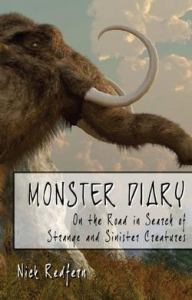Cryptozoology or Parapsychology?
Posted by: Nick Redfern on January 16th, 2013
Yes, it’s time for another post from me designed to raise blood pressure and fury levels….
Over at his blog, Matt Bille has a new post that discusses my Monster Diary book, in relation to the high-strangeness cases I present in its pages, and with specific regard to the matter of things such as a spectral sabre-tooth tiger (a case I describe in the book), and whether or not rogue cases like this should have a place in Cryptozoology or Parapsychology.
You can find Matt’s post here, and here’s my comment to the post:
“Hey Matt,
“Yes, it may well be argued that if a creature exhibits phenomena that is far more paranormal in nature (however we define that term), it may not technically be considered a creature of cryptozoology.
“But, here’s the thing: many creatures that are widely accepted as being part of cryptozoology do exhibit such paranormal (or perceived paranormal) traits.
“Whether people agree with the data and witness testimony or not, there are a lot of Bigfoot reports that are steeped in high strangeness.
“Take, for just one example, Stan Gordon’s 2010 book, Silent Invasion, that chronicles very weird Bigfoot activity in Pennsylvania in 1973.
“Tales of the Yowie in Australia are also saturated with odd overtones.
“FW Holiday, while investigating the Loch Ness Monster, began to experience a lot of high-strangeness, including a MIB sighting at the loch and strange synchronicities.
“Tim Dinsdale alluded to the possibility of a paranormal explanation for Nessie.
“There’s Britain’s Owlman, West Virginia’s Mothman, the ‘pterodcatyls’ of the Texas-Mexico border – all steeped in high strangeness.
“Merrily Harpur’s book, Mystery Big Cats, places the UK’s Alien Big Cats into a non-physical category, a book well worth reading.
“So, if even just one example of high-strangeness in all these cases is valid, using your criteria for what passes as a creature of cryptozooloogy, would we not have to remove all the above ‘things’ from cryptozoological study and hand the data over to paranormal researchers?
“Or, perhaps, we should modify what cryptozoology is and represents.”
About Nick Redfern
Punk music fan, Tennents Super and Carlsberg Special Brew beer fan, horror film fan, chocolate fan, like to wear black clothes, like to stay up late. Work as a writer.











No blood pressure issues. But I’m going with Matt.
1) I have never read anything that leads me to believe there is a connection between the “high strangeness” accounts and the animals, hypothetical or not, that *just happened* to be there when the strangeness occurred.
2) What science cannot confirm, there is no point in searching for.
If there is something interesting to sasquatch or Nessie, the evidence says it’s flesh and blood and testable. Science can do that. It is difficult enough focusing the mainstream on this without adding the “oh by the way, they shape-shift and read your intentions” to the equation.
Now, if one turns into an incorporeal orb in front of a cadre of scientists, it’s game on.
Mr. Redfern, this is an outrage! Why, next you’ll be suggesting that there is a connection between quantum physics and parapsychology. Sacrilege! Seriously, though Monster Diary is exemplary and enjoyable. Thanks!
Iceman:
Quantum physics/parapsychology? Maybe closer than you think, bro.
I mean: bunch of guys who can’t match a pair of socks and can’t remember where they put their keys, and who actually manufacture their eyeglasses out of Coke-bottle bases, telling us all this crap about stuff no one but they can see, and no one but they can check them on. Talk about a racket! At least regular people actually report seeing sasquatch.
I am also with Matt Brille on this one. I think he explains it quite well. If you scour the sighting descriptions at BFRO.net, you discover that the overwhelming majority of alleged sightings describe a very real, living animal, with no “strangeness,” no spectral activitiy, no dissolving away in mists, etc. To fasten on a few remote cases and suggest that these may be exemplary for the whole seems to me something of a mistake. (And for what it’s worth, the first times I saw, respectively, a wild coyote and wild black bear, I felt an initial aura of “strangeness,” as though I was seeing something vastly out of the ordinary…)
DWA: Are you not familiar with the concept of sarcasm:)? I’ll put the abbreviation “scm,” after similar such comments in the future (scm).
I have a sense that this is very much a byproduct of the biases of the researchers/writers exposing the rest of us to their insights into the data.
Nick Redfern has certainly been clear about his zooform frame of reference, and parapsychological sense of almost every “cryptid” he’s ever investigated. There does not seem to be a parapsychology theory that Redfern has encountered that he doesn’t like. That’s fine.
What he fails to see, however, is that all of the writers he usually cites to support his thesis (e.g. Gordon, later writings of Dinsdale & Holiday, Downes, Harpur, and parts of Healey/Cropper), all share his same bias.
He actually interprets the data in a parapsychology fashion by using the writings of people already sharing his tent. But he does not reveal that this “chosen” data are only a small minority of the creature, monster, and cryptid cases.
I too have a bias, and am honest about it. I look at the cryptozoology world via zoology and anthropology, but do not exclude the psychology of the eyewitnesses and the researchers. In this matter, I feel Matt Bille raises a valid point. There is an entire field from which Redfern can study the reports he cherrypicks, and it is called “parapsychology.”
I see no one discouraging him from doing that, but I think this view of his that “we should modify what cryptozoology is” entirely smells too much of colonialism. Cryptozoologists can study the data from whatever angle they wish, but for those who understand that the history of cryptozoology issues first and foremost from zoology, there is firm grounding.
For those who want to add their insights, from whatever angle they wish, there is no one stopping them. Indeed, most cryptozoologists with a foundation in biology do not demand any kind of rigid channeling of the topic in their direction, as Redfern seems to be stating we all should do in our “ology” – our study of this field through his “zooform” and nonzoological screening.
Frankly, I am certainly tired of anyone saying it’s “my way or the highway” in cryptozoology. I’m interested in the zoology in cryptozoology, without excluding an understanding of the psychology too. I don’t think there’s a thing wrong with that.
Ivan T. Sanderson said once that there is no real science in explaining one unknown with another unknown. If Nick Redfern wants to do that, that’s okay with me. I would rather continue studying cryptids and doing my cryptozoology more scientifically by basing my examination of these possible new species by looking at the database through zoology/biology/anthropology, thank you.
I’m with Matt 110% and Loren’s articulate and thoughtful reply doesn’t leave me much to add.
Except that if you take cryptozoology to be a serious science, you don’t mix it with a pseudoscience like parapsychology. After more than a century of serious research what successes can parapsychology claim? Zero.
Corrick: You are comparing apples and oranges. Psychic research has too produced tangible results. Read the book Entangled Minds: Extrasensory Experiences in a Quantum Reality by Dean Radin Ph.D.
Sounds to me like you need to read some good books on critical thinking. Radin has never proven any shred of evidence for psi that has been accepted by any other credible scientists…except for his fellow parapsychologists naturally.
Actually, I have no problem with anyone believing in the paranormal. But please, lump it into the spiritual and supernatural, not into the natural sciences.
I have seen many disciplines “lumped” in with cryptozoology with no adverse effects to the field, other than to encourage a bit of “critical thinking.” Only pompous dullards and purist simpletons would think otherwise.
You could stand to read a more horizon-broadening books yourself. This site “lumps” different disciplines in together all of the time with no more adverse effects other than to stimulate a little bit of “critical thinking”.